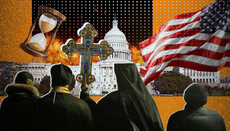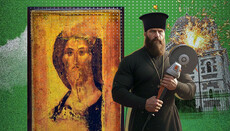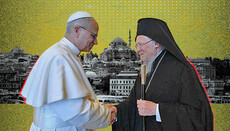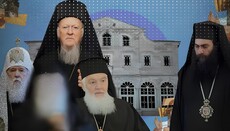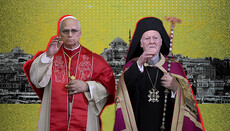Iran and Israel: A war for the Messiah?
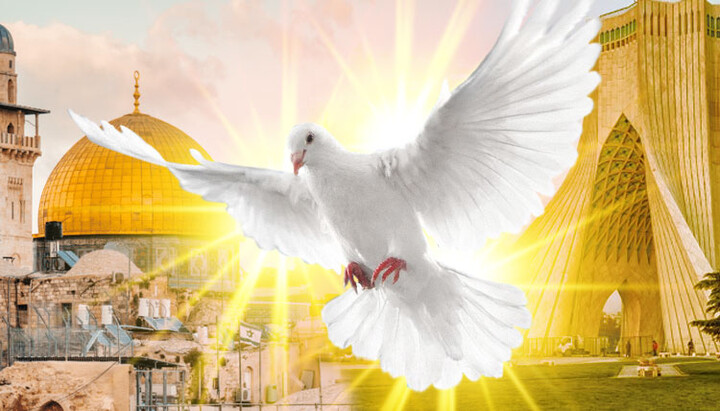
The conflict between Israel and Iran – and, more broadly, with the entire Muslim world – is essentially unresolvable. Yet the path to its resolution is pointed out by Christ.
On the morning of June 24, 2025, what appeared to be a two-week war between Israel and Iran seemingly came to an end. Donald Trump announced that he had brokered a ceasefire between the warring sides, and both parties have officially confirmed the agreement. This is undoubtedly good news – but unfortunately, it’s unlikely that this peace will be permanent or even long-lasting.
Are eschatological prophecies being fulfilled?
We live in a time when many events compel us to pay attention to eschatological prophecies. Many of them are being fulfilled before our very eyes – or at least, that’s how we interpret them. One such prophecy is the restoration of the State of Israel. Just consider this fact: for nearly two thousand years, the Jewish people had no state of their own. They were forbidden to live in the land of Palestine and were scattered across the globe. They had no temple and could not perform their worship in accordance with the Law of Moses.
Today's synagogues are not temples but places where Jews gather to pray and study the Torah with their rabbis. Worship involving sacrifices can be performed in only one place on Earth – the Temple in Jerusalem – and only by priests descended from Aaron. None of this exists today. All that remains is the Western Wall.
And yet the Jewish people did not assimilate into other nations, did not forget their religion, and preserved in their consciousness the dream of restoring the Jewish state. Every generation for two millennia moved toward this goal.
Muammar Gaddafi once pointed out a paradox: why was modern Israel created as a result of the Holocaust perpetrated by the Germans, while it was the Palestinians who had to make way? Why did the 1947 UN resolution propose the establishment of a Jewish state not in Germany, but in Palestine? The answer lies in the Scriptures:
"On that day the Lord made a covenant with Abram, saying, 'To your descendants I give this land, from the river of Egypt to the great river, the Euphrates…'" (Genesis 15:18)
"And I will establish My covenant between Me and you and your descendants after you throughout their generations for an everlasting covenant, to be God to you and your descendants after you. And I will give to you and to your descendants after you the land of your sojournings, all the land of Canaan, for an everlasting possession; and I will be their God" (Genesis 17:7–8).
The Jews left Eretz Israel (the land of Israel) three times:
First, during the time of Jacob, Abraham’s grandson, when they moved to Egypt because of famine and lived there for 400 years.
The second time in 586 B.C., when Babylonian king Nebuchadnezzar II destroyed the First Temple and took the Jews into captivity for 70 years as punishment for idolatry.
The third time in A.D. 70, when Roman emperor Titus destroyed the Second Temple. This exile lasted nearly two thousand years.
The crime that brought about this punishment, we all know.
Yet now Abraham’s descendants are gathering once again in Eretz Israel, and the Jewish state has been restored – precisely in the land God promised to Abraham and his descendants. Today, this land is surrounded by Muslim nations, which launched a war the day after Israel’s declaration of independence in 1948. But the newborn Israel was not swept away by the tide of the Islamic world.
Historians identify six major wars (not including numerous intifadas and escalations):
· 1948–1949 War of Independence
· 1956 Suez Crisis
· 1967 Six-Day War
· 1973 Yom Kippur War
· 1982–1985 Lebanon War
· 2006 Second Lebanon War
In most of these, Islamic states had overwhelming military superiority – but Israel prevailed.
The recent conflict with Iran could easily have surpassed all previous ones in terms of casualties. We don’t yet know its final outcome, nor how long its consequences will play out. But we do know that Jewish prophecy foretells that Israel’s restoration will culminate in the construction of the Third Temple on the site of the previous two, and in the renewal of temple worship. These prophecies link this event with the coming of the Jewish Mashiakh.
Jewish eschatology
In Jewish messianic eschatology, the restoration of the Temple in Jerusalem occupies a central place. References to this are found in the Tanakh (the books of the Hebrew Bible, excluding the deuterocanonical texts), as well as in the Talmud (a collection of legal and religious-ethical teachings of Judaism) and in the writings of rabbis from all eras. Of course, Judaism contains a variety of opinions regarding who the Mashiakh (Messiah) will be, the circumstances of his appearance, and how he will be connected to the Temple in Jerusalem.
However, according to the classical approach – expressed, for example, in the works of the highly authoritative Jewish theologian and philosopher Moses Maimonides (12th century) – the Mashiakh will be a mortal man, wise, God-fearing, and pious in the Jewish understanding of these qualities. In addition, he will be a remarkable political leader, a king, a commander capable of leading millions. It is he who must restore the Temple on its original site in Jerusalem. Moreover, Maimonides states explicitly: if a king from the house of David arises and rebuilds the Temple, then one may be confident that he is the Mashiakh. The Mashiakh must establish the rule of Israel over all nations, who will also accept the Torah and live according to its commandments. In that time, there will be no more wars; all humanity will worship the one true God, and all will live in prosperity, peace, and happiness. This is the Kingdom of God as understood in Judaism.
As for the specific role the Jewish Mashiakh will play in the restoration of the Temple, there is no consensus. Some Jewish theologians insist that only the Mashiakh has the authority to rebuild the Temple, and therefore no one should begin the work until he has revealed himself. Others believe that ordinary Jews must do all the necessary preparation for the Temple’s construction – perhaps even begin building it – and the Mashiakh will come and complete it. This more proactive approach is being taken, for instance, by the Temple Institute in Jerusalem. Its staff have already recreated the golden menorah, the garments of the High Priest, ritual vessels, and other sacred items.
And it seems that everything is moving in that direction, but—
there is one major obstacle: the site where the Jerusalem Temple once stood is now occupied by the third holiest site in Islam, the Al-Aqsa Mosque (built in 705 A.D.), and by the no less revered Dome of the Rock (built in 691 A.D.).
Islamic soly sites and eschatology
The significance of the Al-Aqsa Mosque is underscored in one of the Islamic hadiths: “Journeys should not be undertaken [specifically] except to three mosques: the Sacred Mosque [al-Masjid al-Haram in Mecca], the Mosque of the Messenger [in Medina], and the Al-Aqsa Mosque” (Abu Huraira).
The Dome of the Rock (*Qubbat as-Sakhrah*) is built over the Foundation Stone. In Judaism, this stone is believed to be the cornerstone of creation – the very place from which God began to create the world. It is also believed to have been the site of the Holy of Holies in the Jerusalem Temple. According to the Quran, during the night of *al-Isra wa al-Mi'raj* (the Night Journey and Ascension), the Prophet Muhammad was transported from Mecca to Jerusalem to “the farthest mosque” (*Al-Aqsa*), where he prayed, and then ascended to heaven from the Foundation Stone. Some traditions even claim that Muhammad’s footprint was left on the stone.
Naturally, the Muslim world cannot permit the construction of the Third Temple, as it would entail the destruction of both the Al-Aqsa Mosque and the Dome of the Rock. Such an act would require the total military defeat of Muslim nations.
Yet Jerusalem – and specifically the Temple Mount – is associated in Islam not only with the Prophet Muhammad but also with the future *al-Mahdi* (Messiah). According to Islamic tradition, much like in Judaism, the Mahdi will be a political leader who will unite the *ummah* (the global Muslim community), restore justice, overthrow tyranny, and rule with wisdom and fairness. During his reign, people will live in prosperity and happiness – not according to the Torah, as in Judaism, but according to the Quran and *Sharia*. This is the Muslim understanding of the Kingdom of God.
Jesus Christ (*Isa ibn Maryam*) also has a role in Islamic eschatology. He is expected to descend from heaven and affirm the truth of Islam. He will act together with the Mahdi. The Mahdi will lead the *ummah*, and *Isa* will serve as his spiritual companion. Together, they will defeat the *Dajjal* (the Islamic equivalent of the Antichrist), establish peace, and prepare humanity for the Day of Judgment.
Although *al-Mahdi* is not mentioned explicitly in the Quran, his figure is well-established in hadiths (narrations about the words and deeds of the Prophet Muhammad). For example, one hadith states: “If only one day remained of the world’s existence, Allah would prolong it so that He could send a man from my lineage whose name will be my name, and he will fill the Earth with justice as it had previously been filled with tyranny” (Sunan Abu Dawood).
There is a distinction between Sunni and Shia views of *Mahdism*. Sunnis believe that the Mahdi is a man who will appear in the future – his identity currently unknown. Shia Muslims (and Iran, notably, is a Shia state) believe that the Mahdi was born in the 9th century. His name is Muhammad ibn al-Hasan, and he is still alive, though in occultation. He will reemerge at the appointed time to establish perfect justice.
As we can see, the Jewish and Muslim traditions are mutually exclusive. The *Mashiakh* must establish the rule of the Torah; the *Mahdi*, of the Quran. Though the expected outcomes are similar – peace and prosperity – this raises a crucial question: Where, geographically, is this kingdom of justice and happiness supposed to be established? The answer, in both traditions, is: Jerusalem.
While Judaism expresses this geographical emphasis more explicitly, it is also present in Islam – particularly in Shia tradition. Consider the following quotes:
- “When the *Qa’im* from the lineage of Muhammad (*al-Mahdi*) appears, he will live in Kufa [Iraq], but he will establish his rule over the whole Earth. He will go to *Bayt al-Maqdis* [Jerusalem] and establish justice there...”
(Al-Majlisi, *Bihar al-Anwar*) - “The *Qa’im* will rise from the East... He will purify the Kaaba, then proceed to *Bayt al-Maqdis*, where he will eliminate falsehood and idolatry...” (Muhammad ibn Ibrahim al-Nu‘mani, *Kitab al-Ghayba*)
In Sufism (the ascetic-mystical branch of Islam), there is a legend that the Mahdi will appear in Jerusalem at the Foundation Stone, where he will be met by *Isa ibn Maryam*. Together, they will perform a joint prayer in the Al-Aqsa Mosque. At that moment, the Foundation Stone will either shine with divine light (according to one version) or reveal the hidden knowledge of the end times (according to another).
Of course, the predictions regarding the place and circumstances of the Mahdi’s or the *Mashiakh’s* arrival are not dogmatic doctrines in either Islam or Judaism. Some traditions within these religions give them great importance, others less so. Nevertheless, the current existence of Muslim holy sites on the Temple Mount – and the mutually exclusive eschatological expectations of Jews and Muslims ·make clear that this conflict is fundamentally unsolvable. Only the total victory of one side over the other would resolve it.
But how can all this be addressed in the light of the teachings of Jesus Christ?
Christian understanding of the Kingdom of God
Our Lord Jesus Christ brought to earth a profound revelation about where the one true God is to be worshipped – and, accordingly, where the Kingdom of peace, goodness, and justice, the Kingdom of God, may be established.
When Jesus spoke with the Samaritan woman, she, realizing that she was speaking with a man of God, asked Him about the proper place to worship: “Our fathers worshiped on this mountain, but you say that in Jerusalem is the place where people ought to worship” (John 4:20).
To this, Christ responded: “Believe Me, the hour is coming when neither on this mountain nor in Jerusalem will you worship the Father. You worship what you do not know; we worship what we know, for salvation is from the Jews. But the hour is coming, and is now here, when the true worshipers will worship the Father in spirit and truth, for the Father is seeking such people to worship Him. God is spirit, and those who worship Him must worship in spirit and truth” (John 4:21–24).
The Pharisees also asked Christ about the coming of the Kingdom of God, and He gave them a similar answer: “Being asked by the Pharisees when the Kingdom of God would come, He answered them, ‘The Kingdom of God is not coming in ways that can be observed, nor will they say, “Look, here it is!” or “There!” For behold, the Kingdom of God is within you’” (Luke 17:20–21).
Therefore,
it is meaningless to fight and kill one another over the rebuilding of the Jerusalem Temple or the preservation of the Al-Aqsa Mosque and the Dome of the Rock. No super-just world order will benefit humanity if the Kingdom of God is not present in the human heart.
And for that Kingdom, a far more brutal battle is being waged than for the Temple Mount in Jerusalem – but this war is of a completely different nature. The Apostle Paul describes it in these terms: “For we do not wrestle against flesh and blood, but against principalities, against powers, against the rulers of the darkness of this age, against spiritual hosts of wickedness in the heavenly places” (Ephesians 6:12).
This war cannot be won with rockets, bombs, or even nuclear weapons. It requires something entirely different: “Therefore take up the whole armor of God, that you may be able to withstand in the evil day, and having done all, to stand firm. Stand therefore, having girded your waist with truth, having put on the breastplate of righteousness, and having shod your feet with the preparation of the gospel of peace; above all, taking the shield of faith with which you will be able to quench all the fiery darts of the wicked one. And take the helmet of salvation, and the sword of the Spirit, which is the Word of God” (Ephesians 6:13–17).
As for the coming of the true Messiah – Jesus Christ – it will not be bound to any geographical location: “For as the lightning flashes and lights up the sky from one side to the other, so will the Son of Man be in His day” (Luke 17:24).
